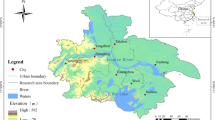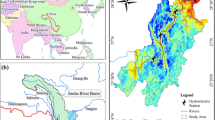Abstract
The spatial pattern of soil erosion can provide valuable insights into the soil erosion processes that require a rapid assessment in practical applications. Generally, quantitative technique is expensive and time-consuming. The objective of this paper is to reveal the spatial pattern of erosion with a rapid assessment method. The affecting factors such as land cover, vegetation fraction and slope gradient are integrated into this method using a qualitative means. Beijing-1 images in 2006 were used to produce land-cover and vegetation fraction, and 1:50,000 topographic maps were used to calculate slope gradient. The study area was classified into six grades. Results show that the upstream area of Guanting Reservoir, in general, is exposed to a moderate risk; there are 17,740.33 km2 of land that suffered from water soil erosion in 2006, occupied 40.69% of the total area, and most of the soil erosion area is on the light and moderate risk, which occupied 25.05 and 62.83% of the eroded area, respectively. Eight elevation zones and six slope gradient zones were overlaid with the assessed risk. The analyzed results show that: (1) the areas above 2,000 m have the lowest erosion risk, which is only 0.75% of the eroded area; 1,250–1,500 m elevation zone has the highest erosion risk, which is 34.72% of the eroded area. (2) The slope gradient zone less than 5 degrees and greater than 35 degrees have the lowest erosion risk, which is 0.02 and 0.75% of the eroded area, respectively; the slope gradient zone with 8–15 degrees has the highest erosion risk, which is 36.40% of the eroded area. These results will be useful for water and soil conservation management and the planning of mitigation measures.


Similar content being viewed by others
References
Beskow S, Mello CR, Norton LD, Curi N, Viola MR, Avanzi JC (2009) Soil erosion prediction in the Grande River Basin, Brazil using distributed modeling. Catena 79(1):49–59
Bissonnais YL, Montier C, Jamagne M, Daroussin J, King D (2001) Mapping erosion risk for cultivated soil in France. Catena 46:207–220
Chen WH, Liu LY, Zhang C, Pan YC, Wang JH, Wang JD (2005) The fast method of soil erosion investigation based on remote sensing (in Chinese, with English abstract). Res Soil Water Conserv 12(6):8–10
Cohena MJ, Shepherdb KD, Walshb MG (2005) Empirical reformulation of the universal soil loss equation for erosion risk assessment in a tropical watershed. Geoderma 124:235–252
Eswaran H, Lal R, Reich PF (2001) Land degradation: an overview. In: Bridges EM, Hannam ID, Oldeman LR, Penning de Vries FWT, Scherr SJ, Sombatpanit S (eds) Response to land degradation. Science Publishers Inc, Enfield, pp 20–35
Hsieh YP, Grant KT, Bugna GC (2009) A field method for soil erosion measurements in agricultural and natural lands. J Soil Water Conserv 64(6):374–382
Kheir RB, Cerdan O, Abdallah C (2006) Regional soil erosion risk mapping in Lebanon. Geomorphology 82:347–359
King C, Delpont G (1993) Spatial assessment of erosion: contribution of remote sensing, a review. Remote Sens Rev 7:223–232
Lal R (2001) Soil degradation by erosion. Land Degrad Dev 12:519–539
Li ZG, Luo ZD (2006) On method for evaluating soil erosion severity in county scale—index of soil erosion severity and its application. Bull Soil Water Conserv 26:41–51
Millward AA, Mersey JE (1989) Adapting the RUSLE to model soil erosion potential in mountainous Tropical Watershed. Catena 28:109–129
Morgan RPC (2005) Soil erosion and conservation. Blackwell Publishing, Malden
Nearing MA, Govers G, Norton LD (1999) Variability in soil erosion data from replicated plots. Soil Sci Soc Am J 63(6):1829–1835
Qiao YL, Qiao Y (2002) Fast soil erosion investigation and dynamic analysis in the loess plateau of China by using information composite technique. Adv Space Res 29:85–88
Renard KG, Kertesz A, Markus B, Richter G (1997) Predicting soil erosion by water: a guide to conservation planning with the Revised Universal Soil Loss Equation. In: Agricultural handbook. United States Department of Agriculture, Washington
Siakeu J, Oguchi T (2000) Soil erosion analysis and modelling: a review. Trans Jpn Geomorphol Union 21(4):413–429
Stroosnijder L (2005) Measurement of erosion: is it possible? Catena 64(2/3):162–173
MWR (Ministry of Water Resources, China) (1997) National professional standards for classification and gradation of soil erosion, SL 190-1996 (in Chinese). Beijing, the People’s Republic of China
Tian YC, Zhou YM, Wu BF, Zhou WF (2008) Risk assessment of water soil erosion in upper basin of Miyun Reservoir, Beijing, China. Environ Geol 57(4):937–942
Vrieling A, Sterk G, Vigiak O (2006) Spatial evaluation of soil erosion risk in the West Usambara Mountains, Tanzania. Land Degrad Dev 17(3):301–319
Vrieling A, De Jong SM, Sterk G, Rodrigues SC (2008) Timing of erosion and satellite data: a multi-resolution approach to soil erosion risk mapping. Int J Appl Earth Obs Geoinf 10:267–281
Wang XD, Zhong XH, Fan JR (2005) Spatial distribution of soil erosion sensitivity on the Tibet Plateau. Pedosphere 15(4):465–472
Xu YQ, Cai YL, Peng J (2008) The effects of land use changes on soil erosion—a case study of the Karst mountainous area in Southwest China. Science Press, Beijing
Zeng DL, Li ZG (2000) Practice of and views on the second national remote sensing investigation on soil erosion (in Chinese). Soil Water Conserv China 1:28–31
Zhang XW, Wu BF, Li QZ (2007) Research on classification of high-resolution remote sensing image. In: Zhang TX, Nardell C, Smith D, Lu HQ (eds) MIPPR 2007: automatic target recognition and image analysis; and multispectral image acquisition. SPIE-The International Society for Optical Engineering, Bellingham, pp 37862Z-1 to 37862Z-7
Zhang XW, Wu BF, Ling F, Zeng Y, Yan NN, Yuan C (2010) Identification of priority areas for controlling soil erosion. Catena 83(1):76–86
Zhao XL, Zhang ZX, Liu B, Wang CY (2002) Method of monitoring soil erosion dynamic based on remote sensing and GIS (in Chinese, with English abstract). Bull Soil Water Conserv 22(4):29–32
Zhou WF, Wu BF (2005) Overview of remote sensing approaches to soil erosion monitoring. Remote Sens Technol Appl 20(5):537–542
Zhou WF, Wu BF, Li QZ (2005) Spatial and temporary change analysis of soil erosion intensity in recent 2 0 years in the upper basin of Guanting reservoir. Res Soil Water Conserv 12(6):183–186
Acknowledgments
The authors acknowledge financial support from the Knowledge Innovation Program of the Chinese Academy of Sciences (Grant No. KZCX1-YW-08-03) and The Second Program of Water and Soil Conservation Remote Sensing Monitoring in the Upper Basin of Guanting Reservoir and Miyun Reservoir supported by Haihe River Water Conservancy Committee, The Ministry of Water Resources, People’s Republic of China (Grant No. HW-STBC2004-03). The authors especially thank the anonymous reviewers, whose constructive comments greatly improved the quality of the manuscript and Mr. Geoff Hart for his detailed edits of the manuscript.
Author information
Authors and Affiliations
Corresponding author
Rights and permissions
About this article
Cite this article
Zhang, X.W., Wu, B.F., Li, X.S. et al. Soil erosion risk and its spatial pattern in upstream area of Guanting reservoir. Environ Earth Sci 65, 221–229 (2012). https://doi.org/10.1007/s12665-011-1085-x
Received:
Accepted:
Published:
Issue Date:
DOI: https://doi.org/10.1007/s12665-011-1085-x




